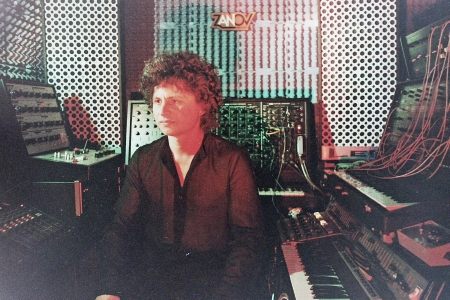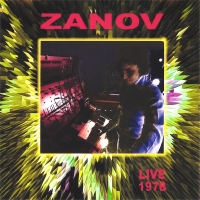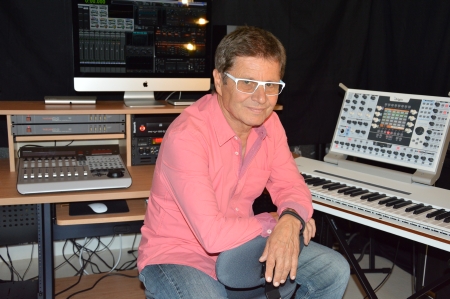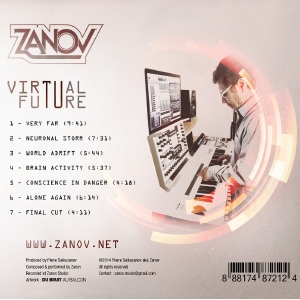Exploring the Universe of Analogue Sounds: ZanovDate: Sept 15 2014 |
||
|
Zanov is the nom de plume of French musician and computer engineer Pierre Salkazanov, who for many remained in vague, if not mysterious realms for a long time. Born in Paris in 1947, Pierre started playing the piano at the age of 6, but was taught to do so in a very old-school fashion. It had nothing to do with the magic of the instrument or the emotional impact of the sound of the notes, but just reproducing what was written on the score-sheets. During this strict regime, Pierre endured many hits of a ruler on his fingers for each mistake he made, but also got the chance occasionally to enjoy the taste of a piece of chocolate when a session was concluded not too bad. Nevertheless, it ended up Mr Salkazanov hating to play the piano for a very long time. When he was about 17 years old, Pierre bought his first e-guitar, which symbolized a true sense of freedom. Not long after that he started playing in a band, although be never considered himself a good player of the instrument. Nonetheless, one thing led to the other and it was not long before the guitar sounds started to bore. The longing for a different and far more versatile spectrum of sounds made him imagine it to be somehow possible to create, mould and arrange sounds through electronic means. We’re talking about 1973 here, a time when Pierre was not yet aware of the existence of synthesizers and associated electronic gear along several musicians already using them for creating music. In that same period, Mr Salkazanov was a student at an engineering high school, which eventually led to a job as a computer design engineer. A few years later, in 1975, Pierre had to undertake a business to London, which offered him the opportunity to visit various music shops in the capital. This occasion would be a turning point, as he ran into one Serge Ramses, who appeared to be a French citizen as well. It was the starting point in discovering the fascinating world of synthesizers that was to follow. After Pierre returned home, he didn’t waste any time and bought his first synthesizer, a VCS3. This exciting piece of gear would change his life as an amateur musician and turned it upside down more than once. Moreover, the instrument offered him the opportunity to break away from the limits of conventional music. A picture of the instrument even made it on the cover of his debut album “Green Ray”, which was composed and played solely with the VCS3. By experimenting endlessly with this fascinating synthesizer, Pierre soon realized he had to understand the foundations of sound synthesis , which was made easier for him due to his engineering and scientific background. In addition, he understood he had to master various playing techniques to a certain level of routine, which would enable him to play and compose in a more fluid way while being led by his own personal emotions. To achieve all this through electronic music though is not a simple task, while it also proved to be very time consuming next to a full-time day job.
In the end, all hard work and strong determination during various nocturnal sessions and weekends finally paid off, as Pierre finished the music of his debut album “Green Ray” in 1977. Now the time had come to publish the outcome of all efforts. So Pierre sat down with his manager to find a proper artist name. As he was already called “Salka” at his day job (as a shortcut of his surname), they decided “Zanov” to be an appropriate choice. On a personal level, Pierre feels he’s in fact the combination of both these faces. A couple of months later, Pierre bought an RMI harmonic synthesizer, which was the only synthesizer which allowed him to apply additive synthesis, and he never saw a competitor for it. This way, he could build sounds by adjusting the 16 first harmonics with sliders that can be moved in real time, allowing creating sounds that are not possible to make with subtractive synthesis. This was very important to him, as Zanov regarded himself more a sound player than a keyboard player, often using the keyboard to control sound parameters, not to play notes.
The aforementioned allowed him to experiment extensively and dive even deeper in the ever expanding universe of electronic sounds, as technology also made some serious steps forward. Still, Zanov’s modus operandi remained the same, building his own sounds and pads from scratch, avoiding any kind of preset in his most personal sonic creations. As Pierre recalls, nothing can beat the fulfilling, most satisfying feeling during the creative process in which one is able to master and give life to an array of unique, emotive sounds. Despite looking for as much freedom as possible to compose, there were always several technical limitations of the equipment showing up, so Pierre had to find tricks and ways to achieve what he heard in his mind.
The final step was mixing down the aforementioned, which always turned out very time consuming as there were various elements on the last two tracks that all required different adjustment in the final mixing. Once again, this was a long learning process with many ups and down in which much had to be memorized along taking many notes to get to the final result right. Zanov performed about ten concerts in 1977 and one in 1978. The latter took place in Villebon (near Paris) and was recorded by Christian Piednoir, who nowadays is known as Alpha Lyra. The recording was done in mono and derived straight from the mixing desk. In Pierre’s view, this is a real pity as his music is supposed to be heard in stereo. Nevertheless, he made arrangements with Christian Piednoir many years later to sell this live recording (“Live 1978”) as a double cd-r through the Cosmicagibi website. The composer himself doesn’t have any other recordings of live gigs in 1977.
In 1979, Zanov completed quite a bit of work for his third album “In Course of Time”, but never reached the point being totally satisfied by the outcome. Meanwhile, Pierre also became much more occupied by other things. One thing led to the other, which would push the release into the ’80’s eventually. Alain Gross and Zanov became acquainted in 1976 after the first had heard music from a promotional tape of “Green Ray”. Gross was looking for an electronic music composer to accompany a singer he has producing. One thing led to the other at the end of 1976, with Alain proposing to produce Zanov’s music as well (most probably after he had reached an agreement on a contract with Polydor Records).
Many captivating musical ideas kept popping up and spinning through Zanov’s head after the completion of “In Course of Time”, which led to a new concept that would blend, music, some spoken poetry (processed through vocoders and synthesizers while integrated profoundly in the music) and video. Pierre started work on “Nous Reprenons Notre Avenir” at the end of 1979, a project which would eventually take 3 to 4 years to complete. Almost all of his weekend, Zanov spent his time in a video recording studio. The latter had a research department which included an EMS analogue video synthesizer (EMS was the same company that manufactured Zanov’s first toy, the VCS3 synthesizer). Here, the composer was grabbed by some new possibilities in his attempt to create some video, sharing some parameters with music synthesis. Unfortunately, this exciting experience stopped just before the end of 1979, as the video recording studio got rid of the video synthesizer and closed its research department. One might imagine Pierre maintained contact with other electronic musicians in his home country, such as Didier Bocquet, Serge Ramses or Tim Blake. This was not the case, as Zanov (being happy on his own) only met a few of them by chance. In the same way he got acquainted to Christian Piednoir, who at that time was writing for a Rock & Roll magazine.
Meanwhile, in 1983 life started getting in the way more seriously. Pierre’s day job as a computer engineer demanded more time than ever as he became responsible for more tasks. His private life changed as well as he became a father. Both meant he had not enough time and space he could dedicate to the way he was used to creating music. Zanov knew the moment had come to make another inevitable, hard choice: he had to take a long break from music, but not one for good. At the same time, he also made a promise to himself he would resume when he was to retire. In 1992, Pierre played his vintage gear only very occasionally, which frustrated him more and more as they were gathering dust and would break down quite often instead of being used properly. Zanov imagined better synthesizers and devices to be available at the time he would retire and resume composing music, offering him a new drive and opportunity to come up with something challenging and new. This made Pierre decide to sell all his synthesizers during 1992. He only kept his recording gear to secure to have access to all the tapes he had. On them is “Nous Reprenons Notre Avenir” along several unreleased compositions. This brings us in the 21st century and almost 30 years later. During this long hiatus, music also kept playing an important part in Zanov’s mind. At times this was very frustrating, as he had no possibility to materialize it, but it also kept the fire burning regarding the promise he made to himself. During 2013, the time was near for Pierre’s retirement, so he slowly started making arrangements to resurface again. Having been out of the music gear scene proved to an eye-opener, when Pierre started tracking down contemporary synthesizers and assorted gear that would suit his needs. He encountered almost nothing that would meet his requirements. He often ished he could turn back time and have access again to his good old vintage instruments. If he were back in 1992, he only would have got rid of the Korg PS3300. To make the best out of it, Pierre finally agreed upon things and acquired an Arturia Origin. This hardware DSP houses several synthesizers, allowing the user to create his own synthesis-patch by connecting independent modules. Despite being a fantastic piece of gear, it still doesn’t offer him all the interconnection options, freedom and flexibility he required and used to have access to in the early days.
In his archive, Pierre re-discovered the initial recordings of his unreleased “Nous Reprenons Notre Avenir”, which never was to his complete satisfaction. He e.g. felt the words of poetry used in it were not clear enough. In the older days he tried another mix-down and lesser processing, but that outcome proved not musical enough despite all efforts. As the core of the project still had lots of potential, Zanov decided to leave out the spoken lyrics. He made a remix and started reworking it for the better. As the original recording was done on an 8-track tape recorder, he had to digitize everything first and fix some details using Pro Tools. During this process, Pierre applied the aforementioned Arturia Origin synthesizer extensively, although he’s still on the look-out for additional synthesizers. Many long hours were spent to achieve the final mix and giving it the right feel, which is slightly different from how Pierre experienced it 30 years ago.
The thoroughly reworked and updated version, celebrating Zanov’s eager revival as a composer, is renamed “Virtual Future” and will be released as a factory-pressed cd in the middle of September 2014.
Discography:
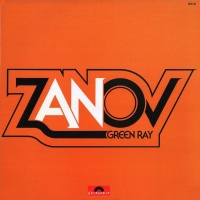

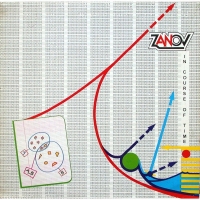
*Nous Reprenons Notre Avenir (unreleased 4th album)* 
Website: www.zanov.net |
||

